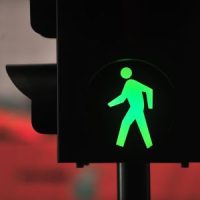Floridians, Take Notice: October Is Pedestrian Safety Month

By Michael Pike, Attorney and Managing Partner, Pike & Lustig LLP
The U.S. Department of Transportation and the Florida Department of Highway Safety and Motor Vehicles (FLHSMV) mark National Pedestrian Safety Month in October. Their goal is to recognize the right of every person to safely co-exist on the streets with motor vehicles and reminds drivers of their responsibility to stay alert for pedestrians, including cyclists and other vulnerable road users.
According to the National Highway Traffic Safety Administration(NHTSA), in 2020, 6,516 pedestrians were killed in the United States by motorists – an average of 18 pedestrians a day. And in 2021, according to the Governors Highway Safety Association, the number of pedestrian deaths was up 17% from the previous year. Eight hundred and ninety-nine of those pedestrians were killed in the Sunshine State in 2021.
To stay safe on the roads, always keep these tips in mind:
Pedestrian Walking Tips:
- Walk on sidewalks whenever they are available. If one isn’t available, walk facing traffic and as far from traffic as possible.
- Pay attention and keep alert at all times. Avoid wearing headphones so that you can hear the traffic and pedestrians around you. Never text or look at your cell phone when crossing the street.
- Whenever possible, cross streets at crosswalks or intersections, where drivers expect pedestrians, and look for cars in all directions, including those turning. If neither are available, locate a well-lit area where you have the best view of traffic. Wait for a gap in traffic that allows enough time to cross safely and watch for traffic as you cross.
- Never enter the street between parked cars. If crossing mid-block cannot be avoided, pedestrians must yield right of way to vehicles on the roadway.
- Do not cross an intersection diagonally except where and when such crossing is authorized by official traffic control devices.
- Watch for cars entering or exiting driveways or backing up in parking lots.
- Be visible at all times. Wear bright clothing during the day and wear reflective materials or use a flashlight at night. Never assume a driver sees you. Make eye contact with drivers as they approach to make sure you are seen.
Pedestrians should always be alert of all the activity surrounding them to best anticipate any situation that may arise. Never assume a car is going to give you the right of way, even if it’s lawfully theirs. Never be an aggressor and always be on the defensive while walking or biking. And if possible, the buddy system is never a bad idea. The rest is up to motorists.
Motorist Safety Tips:
- Look out for pedestrians everywhere, at all times. Use extra caution when driving in hard-to-see conditions, such as nighttime or bad weather.
- Slow down and be prepared to stop when turning or otherwise entering a crosswalk. Never pass vehicles stopped at a crosswalk. There may be people crossing that you can’t see.
- Yield to pedestrians and bicyclists in crosswalks – or ony area where they are legally crossing the street – and stop well back from the crosswalk to give other vehicles an opportunity to see and stop for the crossing pedestrians.
- Always follow the speed limit, especially slower speed limits in school zones and in neighborhoods where children are present.
- As drivers, you have to be prepared to slow or stop at any time – for emergency vehicles, buses, bicyclists, animals, other motorists slowing to turn, and other situations.
- Be extra cautious when backing up—pedestrians can move into your path.
If motorists fail to yield to pedestrians who are crossing legally, they face a minimum citation of $164 and three points on their driver license. Worse, they can severely injury someone – even taking their life. Always remember, motorists and pedestrians share the road, so stay alert and keep each other safe.
Michael Pike is managing partner Pike & Lustig, LLP, a full-service Florida law firm with an emphasis on personal injury and business litigation in Palm Beach, Broward and Dade counties. Learn more at www.turnpikelaw.com.



